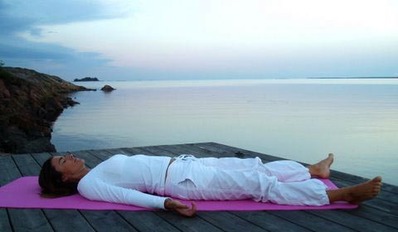|
Yoga Nidra is not a practice, but rather a state of consciousness that can be achieved through particular relaxation techniques, visualizations, and body-awareness meditation. While various methods are used, most of them involve laying on your back with your eyes closed and following the guidance of an instructor’s voice through each body part. Most of all, it's about turning the awareness inward, becoming a witness to the experience, and welcoming whatever arises. Yoga = Union, Oneness Nidra = Sleep Definition: "yogic sleep" or expanded awareness in a state of deep-relaxation Although Yoga Nidra is referred to as “yogic sleep,” you don’t actually sleep, but rather come as close to the sleeping state as you can while remaining awake and present. The goal is that from our deepest level of relaxation, the physiology of the body can return to balance and healing can occur. Some known benefits of relaxation are reduced sympathetic nervous system activity (fight-or-flight response), improved functioning of the immune system, lower blood pressure, slower heart rate, improved circulation, pain reduction, and reduced inflammation. The origins of Yoga Nidra are not precise, yet there is mention of Yoga Nidra in various ancient vedic texts like the Hatha Yoga Pradipika. “Modern” pioneers in the field have been the founder of the Bihar School of Yoga, Swami Satyananda Saraswati and founder of the Himalayan Institute, Swami Rama. More currently, Dr. Richard Miller, the founder of the International Association of Yoga Therapy developed the iRest technique that has been successfully implemented into many VA hospitals and military bases to help PTSD victims. Dr. Richard Miller has also conducted several research studies that have shown the benefits of ongoing relaxation and meditation practices, as well as the unique, altered-state of Yoga Nidra.
“During Yoga Nidra, we intentionally locate and investigate sensations, feelings, emotions, thoughts and images. We go into them. We explore them. We bring them into consciousness. As these impressions are allowed to float freely in awareness, without our trying to repress or express them, they arise and fade away into the background, no longer bothersome to the mind because the mind has no intention to refuse or deny their existence. This approach of pratyahahra (to draw the prana of the subtle senses inward) is a process of elimination whereby unconscious material is allowed to surface into awareness, into consciousness. When repressed material arises without personal reaction, it dissolves.” –Dr. Richard Miller (Developer of iRrest and founder of the Integrative Restoration Institute founded in 2005). “Just sitting quietly, or say watching television, is not enough to produce the physiological changes. You need to use a relaxation technique that will break the train of everyday thought, and decrease the activity of the sympathetic nervous system.” – Dr. Herbert (Benson of Beth Israel Hospital School in Boston, author of the Relaxation Response 1975 with updates edition in 2000). Through PET and EEG recording, the Scandinavian Yoga and Meditation School (Nov. 12, 2009) found that Yoga Nidra takes people into Theta state with secondary Alpha waves meaning simultaneous deep meditation and awareness. This confirms that meditation is a fourth major state of consciousness in addition to dreaming, sleeping, and wakefulness. One can be completely aware in a deep state and one can consciously experience and control the brain’s activity simultaneously. Overall, experiencing Yoga Nidra on a regular basis is a valuable complementary approach to supporting any healing process and to ensure overall wellbeing. Sources & Resources: Integration Restoration Institute - www.irest.us Books: Yoga Nidra by Swami Satyananda Saraswati and Yoga Nidra: A Meditative Practice for Deep Relaxation and Healing by Richard Miller
1 Comment
 There is always an excitement in the air when spring arrives. Colorful buds are blossoming, more birds are chirping, and new shoots are pushing their way through the earth. Even though winter here in Northern California was extraordinarily mild, you can feel a freshness and anticipation for the months to come. Today on the Equinox there is equal light and darkness - an end of winter and the beginning of a three month journey to the Summer Solstice. For several years now I've been studying yoga with Shiva Rea and learning about syncing with the rhythms of nature through various practices. Her new book, Tending the Heart Fire, beautifully illustrates the solar and lunar cycles of the year and ceremonies that take place across the world around these "sacred junctures." Living in a culture that in many ways lacks stories and myths that connect us to our environment, I find it even more important that we create some kind of ritual around these transitions. Whatever it may be, I hope we can all encourage each other to pause, reflect back, and envision the season ahead. Here are few reflective questions that might be useful to contemplate as the landscape changes around us and within us: *What needs to be released and let go of before entering this new season? *What seeds are you wanting to plant for the rest of the year? *What dietary shifts are appropriate? (a.k.a. what is the earth providing us with now?) *What lifestyle practices need readjusting? I'll be writing more posts about specific Ayurvedic practices for Springtime. Until then, I recommend taking Maria Garre's webinar on April 2nd or detoxing and staying allergy-free, or reading Dr. John Douillard's article on cleansing. Also, on April 11th I'll be giving a talk at the Center for Inner Health and Stillness on tips for staying balanced in the spring. Follow this blog by email or contact me for more info and updates. Have a wonderful Equinox - may we bring ourselves fully into this new season! |
"harmonize with nature, walk a path
of balance" ❤ Newsletter ArchiveSpring/Summer 2024
Winter 2024 Summer 2021 Spring Retreat 2021 Spring 2021 Winter 2021 Spring 2020 Winter 2020 Summer 2019 Winter 2019 Autumn 2018 Spring 2018 Winter 2018 Fall 2017 Summer 2017 First Seasonal Newsletter Categories
All
Archives
June 2024
|

 RSS Feed
RSS Feed